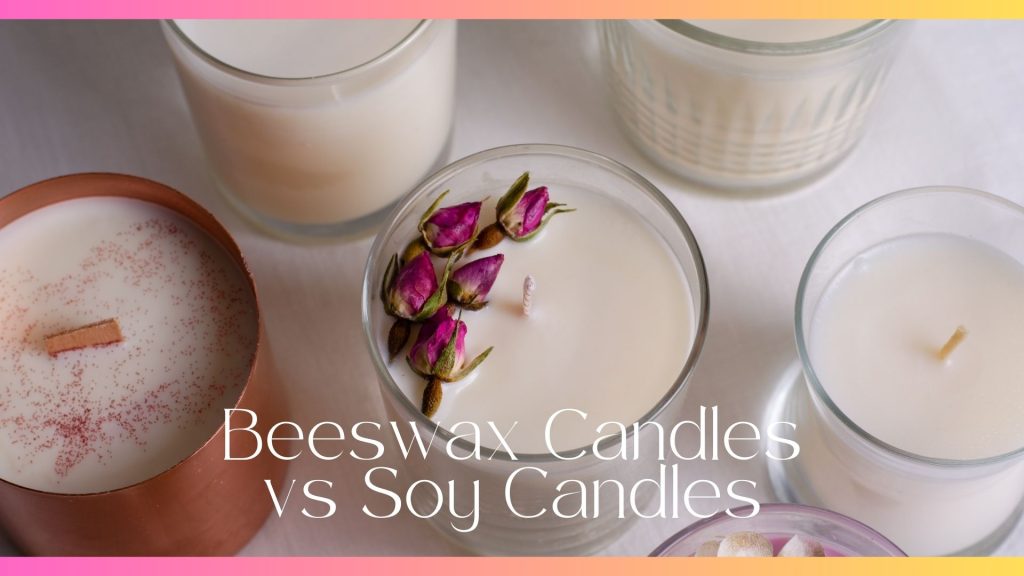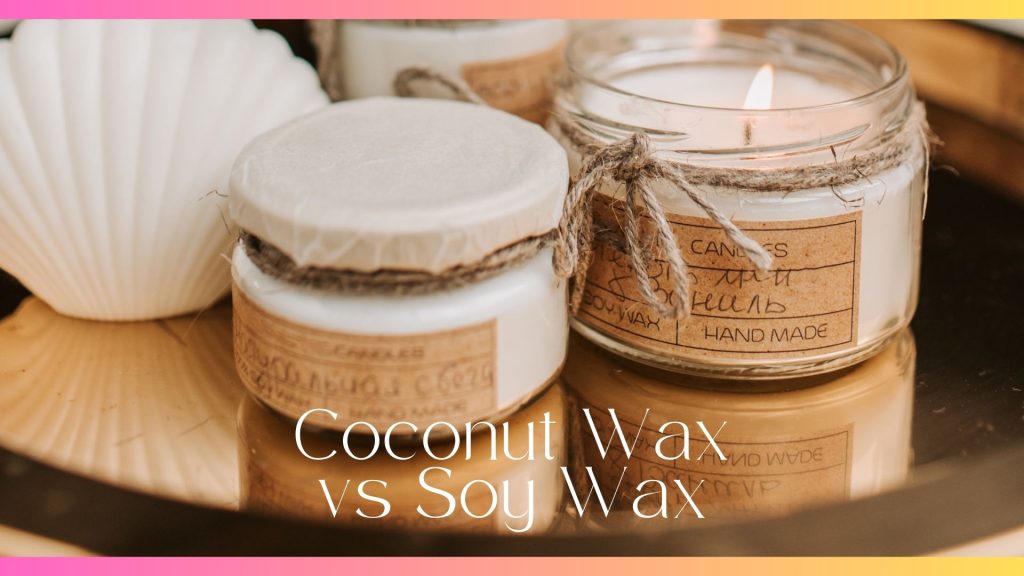Beeswax candles have been used for centuries, valued for their natural ingredients and unique properties. But are beeswax candles better than the other more popular options out there?
In this article, I’ll share some known benefits of beeswax candles, compare them to alternatives like paraffin and soy candles. I’ll also explain a bit on their environmental impact, health benefits, and a few reasons why you may not prefer them.
Disclaimer: This post may contain affiliate links. This means I may earn a small commission (at no cost to you) if you sign up for a program or make a purchase using my link!
Related Posts:
- How To Make Rolled Beeswax Candles: A Step-by-Step Guide
- Beeswax Candles vs Soy Candles: 6 Key Differences
- How To Care For Candles – 9 Best Practices
Understanding Beeswax Candles
If you’re new to candle-making, or beeswax candle-making, then it’s good to know that – beeswax candles are candles made using wax produced by honeybees. Compared to other types of waxes like soy, coconut or paraffin, this natural wax is renowned for its clean-burning properties, subtle honey scent, and golden hue.
Beeswax candles are generally a little more difficult to find but they come in various shapes and sizes, from classic taper candles to decorative pillars and votives.
Benefits of Beeswax Candles
Beeswax candles offer a range of benefits, including:
- Clean Burn: Beeswax candles produce minimal smoke and soot, making them a healthier option for indoor air quality.
- Longer Burn Time: Beeswax candles tend to burn longer than paraffin candles, providing hours of gentle illumination.
- Natural Ingredients: Beeswax candles are made from natural ingredients, free from harmful additives or synthetic fragrances.
1. Environmental Benefits
Beeswax candles have a minimal environmental impact compared to paraffin candles. It uses a renewable resource that does not require extensive processing or contribute to deforestation or pollution.
Additionally, beeswax candles biodegrade naturally, posing no harm to the environment when disposed of properly.
2. Health Benefits
The natural ingredients in beeswax candles, such as beeswax and pure essential oils, offer potential health benefits, including:
- Air Purification: Beeswax candles emit negative ions when burned, which can help neutralize pollutants and allergens in the air, improving indoor air quality.
- Aromatherapy: Many beeswax candles are scented with pure essential oils, which can have therapeutic effects on mood and well-being, promoting relaxation and stress relief.
3. Spiritual Benefits
Beeswax candles are often associated with various spiritual benefits:
- Purification: The negative ions released can help cleanse the air and create a purifying atmosphere.
- Natural light: The warm, golden glow of beeswax candles is said to promote a sense of peace and tranquility.
- Aromatherapy: The subtle honey scent can enhance relaxation and meditation practices.
- Sustainability: Using a natural, renewable resource aligns with eco-conscious spiritual practices.
These qualities make beeswax candles a popular choice for spiritual and meditative activities.
4. Aesthetics and Ambiance
In addition to their health and environmental benefits, beeswax candles add warmth and ambiance to any space. Their soft, golden glow creates a cozy atmosphere, perfect for relaxation, meditation, or romantic evenings.
3 Things To Differentiate: Beeswax vs. Paraffin Candles
Compared to paraffin candles, beeswax candles have several advantages:
- Healthier Option: Paraffin candles are made from petroleum by-products and may release harmful toxins and pollutants when burned, whereas beeswax candles are non-toxic and produce minimal emissions.
- Cleaner Burn: Beeswax candles produce less soot and smoke than paraffin candles, resulting in cleaner air and less residue buildup on walls and surfaces.
- Renewable Resource: Beeswax is a natural by-product of honey production, making it a sustainable and environmentally friendly choice.
3 Things To Compare: Beeswax vs. Soy Candles
To compare beeswax candles and soy candles, consider the following three aspects:
1. Health and Emissions
- Beeswax Candles: Beeswax candles are non-toxic and produce minimal emissions. They burn cleanly with little to no soot, which can help maintain cleaner air quality indoors.
- Soy Candles: Soy candles are also a healthier option compared to paraffin candles. They produce less soot and fewer pollutants, making them a safer choice for indoor air quality.
2. Burn Characteristics
- Beeswax Candles: Beeswax candles have a longer burn time due to their high melting point. They produce a bright, warm flame similar to natural sunlight and have a subtle, natural honey scent.
- Soy Candles: Soy candles generally burn slower than paraffin but not as long as beeswax. They have a cooler burn temperature and can be easily scented with essential oils, offering a wider range of fragrances.
3. Sustainability and Environmental Impact
- Beeswax Candles: Beeswax is a renewable resource, being a natural by-product of honey production. It is sustainable and environmentally friendly, supporting beekeeping and biodiversity.
- Soy Candles: Soy wax is made from soybean oil, which is also a renewable resource. However, the environmental impact depends on agricultural practices, including the use of pesticides and land use for soybean farming. Soy candles are biodegradable and generally considered eco-friendly.
Comparison Table: Beeswax vs. Soy Candles
| Aspect | Beeswax Candles | Soy Candles |
|---|---|---|
| Health and Emissions | Non-toxic, minimal emissions, cleaner air | Non-toxic, less soot and pollutants |
| Burn Characteristics | Longer burn time, bright warm flame, natural honey scent | Moderate burn time, cooler burn temperature, easily scented |
| Sustainability | Renewable, by-product of honey production, eco-friendly | Renewable, depends on farming practices, biodegradable |
Pros & Cons of Beeswax Candles
In discovering whether beeswax candles are better, we need to compare both advantages and disadvantages of using beeswax candles – for the average user and candle-maker.
Why Are Beeswax Candles Better?
Beeswax candles are often considered superior to other types of candles for several reasons:
- Cleaner burning: They produce minimal soot and smoke, improving indoor air quality.
- Longer burn time: Beeswax candles burn longer due to their higher melting point.
- Natural: Made from a renewable resource, they are environmentally friendly.
- Air purification: They release negative ions that can help purify the air.
- Eco-friendly: Made from a renewable resource.
However, their higher cost and limited aesthetic options might not suit everyone’s preferences.
Are Beeswax Candles Bad?
While beeswax candles have many advantages, some drawbacks exist:
- Cost: They are more expensive than paraffin or soy candles due to the labor-intensive process of harvesting beeswax.
- Color and scent: Beeswax candles typically come in natural yellow or light brown colors and have a subtle honey scent, which might not appeal to everyone.
- Sustainability concerns: There are questions about the environmental impact and ethical sourcing of beeswax, despite it being more eco-friendly than paraffin.
Yes, there are potential allergy issues with beeswax candles, although they are generally rare and less common compared to other types of candles. Here are some considerations:
Potential Allergy Issues with Beeswax Candles
1. Bee-Related Allergies
- Pollen Residue: Beeswax may contain trace amounts of pollen or propolis, which can trigger allergies in individuals sensitive to these substances.
- Bee Allergens: People with severe allergies to bee stings or bee products might experience reactions when exposed to beeswax.
2. Asthma and Respiratory Sensitivity
- Smoke Sensitivity: Although beeswax candles produce less soot and smoke compared to paraffin candles, any smoke can still be an irritant for individuals with asthma or respiratory conditions.
- Scent Sensitivity: The natural honey scent of beeswax candles, while generally mild, could potentially cause discomfort for those with scent sensitivities.
| Candle Type | Allergy Potential | Common Triggers | Severity |
|---|---|---|---|
| Beeswax Candles | Low | Trace pollen, propolis, bee allergens | Mild to moderate (rare cases) |
| Soy Candles | Low to Moderate | Soy protein, added fragrances | Mild to moderate |
| Paraffin Candles | Moderate to High | Petrochemicals, added fragrances | Moderate to severe (more common) |
While beeswax candles are generally considered hypoallergenic and safe for most people, those with specific allergies to bee products or respiratory sensitivities should exercise caution.
Are Beeswax Candles Better for Candle-making?
Beeswax candles are excellent for candle making due to their natural properties:
- High melting point: Results in a longer burn time and less dripping.
- Clean burning: Produces minimal soot and smoke, making them ideal for indoor use.
- Natural: Made from renewable resources, they are environmentally friendly.
- Scent: The subtle honey aroma is pleasant and natural.
However, the higher cost of beeswax and its limited color and scent options may pose challenges for some candle makers.
Bottom Line
Beeswax candles offer numerous advantages over paraffin candles and even soy candles, including cleaner burning, environmental sustainability, and potential health benefits.
Whether you’re looking to improve indoor air quality, reduce your carbon footprint, or enhance the ambiance of your home, beeswax candles are a natural and eco-friendly choice.
Frequently Asked Questions (FAQs)
Beeswax candles, despite their many benefits, have some disadvantages. They are generally more expensive than paraffin or soy candles due to the labor-intensive process of harvesting beeswax and its limited production by bees. Their natural colors, typically yellow or light brown, might not match everyone’s aesthetic preferences. The subtle honey scent of beeswax may not satisfy those who prefer stronger fragrances. While beeswax is eco-friendly, there are concerns about the sustainability and ethical sourcing of beeswax.
Beeswax candles are often considered superior to regular, particularly paraffin, candles. They burn cleaner, with minimal soot and smoke, improving indoor air quality. Beeswax candles also have a longer burn time due to their higher melting point and emit a natural, mild honey scent. Unlike paraffin candles, which are petroleum-based, beeswax candles are natural and renewable. However, their higher cost and limited color and scent options may not appeal to everyone.
Choosing between beeswax and soy candles depends on personal preferences. Beeswax candles burn cleaner, longer, and emit a natural honey scent. They also release negative ions that can help purify the air. Soy candles, made from soybean oil, are generally less expensive and available in a wider range of colors and fragrances. They are biodegradable and burn cleaner than paraffin, though not as clean as beeswax. If you value longevity and natural products, beeswax is ideal. For more variety and a lower cost, soy candles are a good choice.
Switching to beeswax candles offers numerous benefits. They burn longer and cleaner than paraffin candles, producing minimal smoke and soot, thus improving indoor air quality. Beeswax candles emit a natural honey scent and a warm glow, creating a cozy atmosphere. They also release negative ions, which can help purify the air by neutralizing pollutants and allergens. Beeswax is a renewable resource, making these candles environmentally friendly. By choosing beeswax candles, you support sustainable beekeeping practices and enjoy a natural, health-beneficial product.


